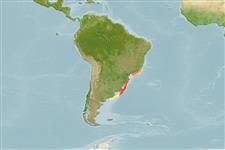Common names from other countries
Klassifizierung / Names
Namen | Synonyme | Catalog of Fishes(Gattung, Arten) | ITIS | CoL | WoRMS | Cloffa
>
Ophidiiformes (Cusk eels) >
Ophidiidae (Cusk-eels) > Ophidiinae
Etymology: Genypterus: Greek, geny, -yos = face, jaw + Greek, pteron, = wing, fin (Ref. 45335).
More on author: Regan.
Issue
This species is synonym of Genypterus blacodes (Forster, 1801) according to Nielsen et al. (1999: Ref. 34024). The species page will be removed.
Environment: milieu / climate zone / depth range / distribution range
Ökologie
seewasser demersal; tiefenbereich 60 - 200 m (Ref. 9358). Subtropical; 21°S - 40°S, 62°W - 40°W
Southwest Atlantic: Rio de Janeiro, Brazil (Ref. 9358) to northern Argentina (Ref. 27363). Appears to be an unpatterned form of blacodes; status of this species unclear (Ref. 34024).
Size / Gewicht / Alter
Maturity: Lm ? range ? - ? cm
Max length : 68.8 cm SL Männchen/unbestimmt; (Ref. 27363)
Found on soft mud bottom. Oviparous, with oval pelagic eggs floating in a gelatinous mass (Ref. 205).
Life cycle and mating behavior
Maturities | Fortpflanzung | Spawnings | Egg(s) | Fecundities | Larven
Figueiredo, J.L. and N.A. Menezes, 1978. Manual de peixes marinhos do sudeste do Brasil. II. Teleostei (1). Museu de Zoologia, Universidade de São Paulo. Brasil. 110 p. (Ref. 9358)
IUCN Rote Liste Status (Ref. 130435)
CITES (Ref. 128078)
Not Evaluated
Bedrohung für Menschen
Harmless
Nutzung durch Menschen
Fischereien: weniger kommerziell
Tools
Zusatzinformationen
Download XML
Internet Quellen
Estimates based on models
Preferred temperature (Ref.
115969): 16.2 - 20.4, mean 18.6 (based on 28 cells).
Phylogenetic diversity index (Ref.
82804): PD
50 = 0.5156 [Uniqueness, from 0.5 = low to 2.0 = high].
Bayesian length-weight: a=0.00204 (0.00125 - 0.00334), b=3.16 (3.01 - 3.31), in cm Total Length, based on LWR estimates for this species & (Sub)family-body (Ref.
93245).
Trophic level (Ref.
69278): 4.0 ±0.66 se; based on food items.
Widerstandsfähigkeit (Ref.
120179): mittel, Verdopplung der Population dauert 1,4 - 4,4 Jahre. (Preliminary K or Fecundity.).
Fishing Vulnerability (Ref.
59153): Moderate to high vulnerability (54 of 100).
